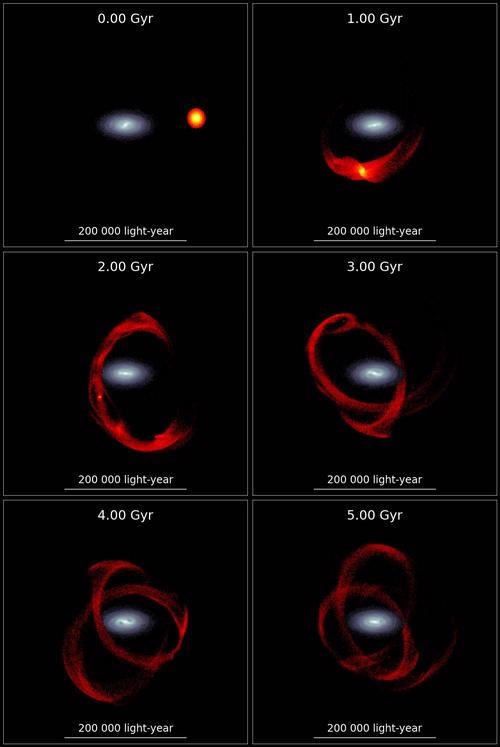Mar 3 2021
Several river-like structures formed of numerous stars occur around the Milky Way galaxy. These structures are known as stellar streams, and how they form remains a mystery.
 The simulated process of Cetus Stream progenitor merging with the Milky Way. Image Credit: Jiang Chang.
The simulated process of Cetus Stream progenitor merging with the Milky Way. Image Credit: Jiang Chang.
Headed by Prof. Gang Zhao and Dr Jiang Chang, a team of researchers from the National Astronomical Observatories of the Chinese Academy of Sciences (NAOC) simulated the process of formation of the newly identified Cetus stream using a computer. The study has been reported in The Astrophysical Journal.
Stellar streams are the remnants of dwarf satellite galaxies that are swallowed by the Milky Way, but have not been fully digested. The accretion process is not that the Milky Way swallowed the dwarf galaxy in one bite, but it peeled the dwarf galaxy layer by layer from outside to inside by tidal stripping, just like peeling an onion. The stripped stars distributed in their original orbits, and they formed a river-like structure, that is, a stellar stream.
Dr Jiang Chang, Study First Author, National Astronomical Observatories, Chinese Academy of Sciences
The Milky Way galaxy expands by continuously gobbling dwarf satellite galaxies, known as the galaxy merger. An investigation of the Milky Way’s merging history can reveal how the Milky Way formed and evolved.
In an earlier study, the research team discovered the Cetus stream using the observational data obtained from the Large Sky Area Multi-Object Fiber Spectroscopic Telescope (LAMOST, also called Guoshoujing Telescope) Survey and the Sloan Digital Sky Survey.
They have now replicated the formation history of this stellar stream using the supercomputer with a series of high-resolution dynamics numerical simulations. They have come up with a simple portrait of the Cetus Stream progenitor before it was devoured by the Milky Way.
Our work shows how the Milky Way slowly peeled apart and swallowed a dwarf galaxy with a mass of about 20 million times of the sun over a period of 5 billion years.
Gang Zhao, Study Co-Corresponding Author and Professor, National Astronomical Observatories, Chinese Academy of Sciences
All satellite galaxies contain a core structure that is made of comparatively dense stars. Certain researchers hypothesize that the globular star cluster NGC 5824 is a core structure related to the Cetus Stream. However, in this study, the researchers reversed this hypothesis by performing detailed numerical simulations.
“The globular cluster NGC 5824 is not the remnant core structure corresponding to the Cetus stream, because the dynamic feature is not correct,” added Dr CHANG. “But we found that there is a strong correlation between the two. NGC 5824 should be a globular cluster in the Cetus stream progenitor galaxy.”
In general, stellar streams are distributed throughout the sky. While LAMOST was helpful in finding the Cetus stream in the northern sky, the team also identified the candidate counterpart of the Cetus stream in the southern sky, namely, the Palca stream.
There are a large number of merging relics in the Milky Way similar to the Cetus stream. They compose a treasure house for studying the structure and formation history of the Milky Way, which helps us to better understand how galaxies in the universe have formed and evolved.
Gang Zhao, Study Co-Corresponding Author and Professor, National Astronomical Observatories, Chinese Academy of Sciences
Journal Reference:
Chang, J., et al. (2021) Is NGC 5824 the Core of the Progenitor of the Cetus Stream? The Astrophysical Journal. doi.org/10.3847/1538-4357/abc338.